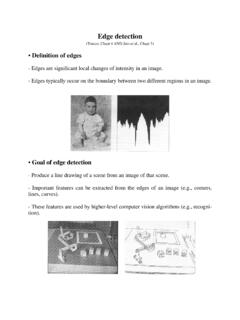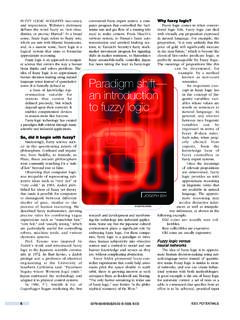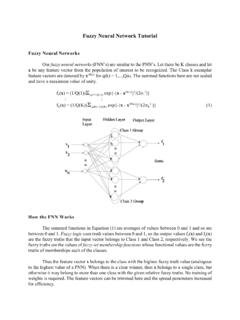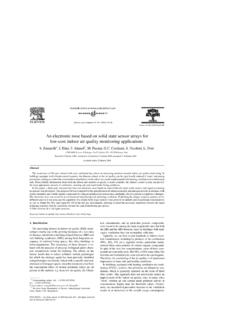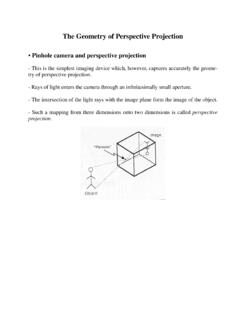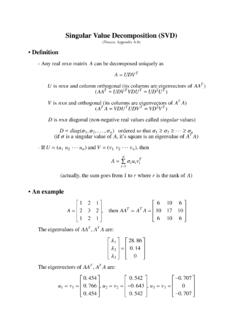Transcription of MATRIX ALGEBRA REVIEW - University of Nevada, Reno
1 MATRIX ALGEBRA REVIEW (PRELIMINARIESA MATRIX is a way of organizing is a rectangular array of elements arranged in rows and columns. For example, the following matrixA has m rows and n elements can be identified by a typical element ija, where i=1,2,..,m denotes rows and j=1,2,..,ndenotes MATRIX is of order (or dimension) m by n (also denoted as (m x n)).A MATRIX that has a single column is called a column MATRIX that has a single row is called a row transpose of a MATRIX or vector is formed by interchanging the rows and the columns. A MATRIX oforder (m x n) becomes of order (n x m) when example, if a (2 x 3) MATRIX is defined by Then the transpose of A, denoted by A , is now (3 x 2) AA= )( AkkA = )(, where k is a scalar. = =232221131211aaaaaaA = 231322122111aaaaaaA2 SYMMETRIC MATRIXWhen AA= , the MATRIX is called symmetric. That is, a symmetric MATRIX is a square MATRIX , in that ithas the same number of rows as it has columns, and the off-diagonal elements are symmetric ( ).)
2 For example,A special case is the identity MATRIX , which has 1 s on the diagonal positions and 0 s on the off-diagonal identity MATRIX is a diagonal MATRIX , which can be denoted by ),..,,(21naaadiag, where ia is theith element on the diagonal position and zeros occur elsewhere. So, we can write the identity MATRIX as)1,..,1,1(diagI=.ADDITION AND SUBTRACTIONM atrices can be added and subtracted as long as they are of the same dimension. The addition ofmatrix A and MATRIX B is the addition of the corresponding elements of A and B. So, BAC+=implies that ijijijbac+= for all i and example, ifThen ABBA = )()(CBACBA = BABA = )( =100010001 LMOMMLLI = =856010632BA =21132C =1023275354A3 MULTIPLICATIONIf k is a scalar and A is a MATRIX , then the product of k times A is called scalar multiplication. Theproduct is k times each element of A. That is, if kAB=, then ijijkab= for all i and the case of multiplying two matrices, such as ABC=, where neither A nor B are scalars, it must bethe case thatthe number of columns of A = the number of rows of BSo, if A is of dimension (m x p) and B of dimension (p x n), then the product, C, will be of order (m xn) whose ijth element is defined asIn words, the ijth element of the product MATRIX is found by multiplying the elements of the ith row of A,the first MATRIX , by the corresponding elements of the jth column of B, the second MATRIX , and summingthe resulting product.
3 For this to hold, the number of columns in the first MATRIX must equal thenumber of rows in the example, A (m x 1) column vector multiplied by a (1 x n) row vector becomes an (m x n) MATRIX . A (1 x m) row vector multiplied by a (m x 1) column vector becomes a scalar. In general,BAAB . But, AkkA= if k is a scalar and A is a MATRIX . And, IAAI= if A is a MATRIX and I is the identity MATRIX and conformable for product of a row vector and a column vector of the same dimension is called the inner product(also called the dot product), its value is the sum of products of the components of the vectors. Forexample, if j is a (T x 1) vector with elements 1, then the inner product, j j, is equal to a constant : two vectors are orthogonal if their inner product is zero. ACABCBA+=+)(. BCACCBA+=+)(. ==pkkjikijbac1 ==5291834286 ADF + + + ++ +=5*41*)2(2*4)8(*)2(9*43*)2(5*81*62*8)8( *69*83*6 =1824304632904 CABBCA)()(=.
4 A MATRIX with elements all zero is called a null MATRIX . ABAB = )(. ABCABC = )(.TRACE OF A SQUARE MATRIXThe trace of a square MATRIX A, denoted by tr(A), is defined to be the sum of its diagonal ++++=..)(332211 AAtr=)(, if A is a scalar. )()(AtrAtr= , because A is square. )()(AtrkkAtr =, where k is a scalar. nItrn=)(, the trace of an identity MATRIX is its dimension. )()()(BtrAtrBAtr = . )()(BAtrABtr=. === = ninjijaAAtrAAtr112)()(.DETERMINANT OF A SQUARE MATRIXThe determinant of a square MATRIX A, denoted by det(A) or A, is a uniquely defined scalar numberassociated with the ) for a single element MATRIX (a scalar, 11aA=), det(A) = ) in the (2 x 2) case, =22211211aaaaAthe determinant is defined to be the difference of two terms as follows,21122211aaaaA =which is obtained by multiplying the two elements in the principal diagonal of A and then subtractingthe product of the two off-diagonal ) in the (3 x 3) case,5 =333231232221131211aaaaaaaaaA32312221133 3312321123332232211aaaaaaaaaaaaaaaA+ =iv) for general cases, we start first by defining the minor of element ija as the determinant of thesubmatrix of A that arises when the ith row and the jth column are deleted and is usually denoted asijA.
5 The cofactor of the element ija is ijjiijAc+ =)1(. Finally, the determinant of an n x n matrixcan be defined asnirowanyforcaAnjijij,..,2,11== =.njcolumnanyforcaniijij,..,2,11== =. AA= dbcakdkbckakdbkca== AkkAn=, for scalar k and n x n MATRIX A. If any row (or column) of a MATRIX is a multiple of any other row (or column) then the determinantis zero, )(= ==ababkbbaakkbbkaa If A is a diagonal MATRIX of order n, then nnaaaAL2211= If A and B are square matrices of the same order, then BAAB=. In general,BABA+ +RANK OF A MATRIX AND LINEAR DEPENDENCYRank and linear dependency are key concepts for econometrics. The rank of any (m x n) MATRIX can bedefined ( , the MATRIX does not need to be square, as was the case for the determinant and trace) andis inherently linked to the invertibility of the rank of a MATRIX A is equal to the dimension of the largest square submatrix of A that has anonzero determinant. A MATRIX is said to be of rank r if and only if it has at least one submatrix oforder r with a nonzero determinant but has no submatrices of order greater than r with example, the matrix6 =59212871082169314254 Ahas rank 3 because 0=A, but 0637108693254 =That is, the largest submatrix of A whose determinant is not zero is of order concept of rank also can be viewed in terms of linear dependency.
6 A set of vectors is said to belinearly dependent if there is a nontrivial combination ( , at least one coefficient in the combinationmust be nonzero) of the vectors that is equal to the zero vector. More precisely, denote n columns ofthe MATRIX A as naaa,,,21K. This set of these vectors is linearly dependent if and only if there existsa set of scalars },,,{21ncccK, at least one of which is not zero, such that 0aaa=+++ the above example, the columns of the MATRIX A are linearly dependent because,0= + + 528211419762021095218341If a set of vectors is not linearly dependent, then it is linearly independent. Also, any subset of alinearly independent set of vectors is linearly the above example, the first three columns of A are linearly independent, as are the first twocolumns of A. That is, we cannot find a set of scalars (with at least one nonzero) such that the linearcombination of scalars and columns equals the zero connection between linear dependency and the rank of a MATRIX is as follows: the rank of amatrix A may be defined as the maximum number of linearly independent columns or rows of other words, the maximum number of linearly independent columns is equal to the maximumnumber of linearly independent rows, each being equal to the rank of the MATRIX .
7 If the maximumnumber of linearly independent columns (or rows) is equal to the number of columns, then the matrixhas full column rank. Additionally, if the maximum number of linearly independent rows (orcolumns) is equal to the number of rows, then the MATRIX has full row rank. When a square MATRIX Adoes not have full column/row rank, then its determinant is zero and the MATRIX is said to be a square MATRIX A has full row/column rank, its determinant is not zero, and the MATRIX is said tobe nonsingular (and therefore invertible). Full rank (nonsingular MATRIX ) 0A A is , the maximum number of linearly independent (m x 1) vectors is m. For example,consider the following set of two linearly independent vectors, 4321If there is a third vector, =21bbbwhere 21bandb can be any numbers, then the three unknown scalars 321,,candcc can always befound by solving the following set of equations, = + + other words, the addition of any third vector will result in a (2 x 3) MATRIX that is not of full rank andtherefore not speaking, this is because any set of m linearly independent (m x 1) vectors are said to spanm-dimensional space.
8 This means, by definition, that any (m x 1) vector can be represented as a linearcombination of the m vectors that span the space. The set of m vectors therefore is also said to form abasis for m-dimensional space. nIrankn=)( )()(ArankkArank=, where k is a nonzero constant )()(ArankArank= If A is an (m x n) MATRIX , then },min{)(nmArank . If A and B are matrices, then )}(),(min{)(BrankArankABrank . If A is an (n x n) MATRIX , then nArank=)( if and only if A is nonsingular; nArank<)( if andonly if A is are operations on the rows/columns of a MATRIX that leave its rank unchanged: Multiplication of a row/column of a MATRIX by a nonzero constant. Addition of a scalar multiple of one row/column to another row/column. Interchanging two OF A MATRIXThe inverse of a nonsingular (n x n) MATRIX A is another (n x n) MATRIX , denoted by A-1, that satisfiesthe following equalities: IAAAA== 11. The inverse of a nonsingular (n x n) MATRIX is inverse of a MATRIX A in terms of its elements can be obtained from the following formula:8 []ijjiijijAcandcCwhereACA+ = = =)1(1 Note that C is the transpose of the MATRIX of cofactors of A as defined in the section on is also called the adjoint of example, let = (A) = -2 and the cofactors are 2,3,1,421122211 = ===cccc.
9 So, the inverse is calculated as, = = II= 1 AA= 11)( )()(11 = AA If A is nonsingular, then 1 A is nonsingular. If A and B are nonsingular, then 111)( = FOR SYSTEMS OF SIMULTANEOUS LINEAR EQUATIONSC onsider the following system of linear equations: bAx=where A is a (m x n) MATRIX of knowncoefficients, x is a (n x 1) vector of unknown variables, and b is a (m x 1) vector of known want to find the conditions under which: 1) the system has no solution, 2) the system has infinitelymany solutions, 3) the system has a unique solution. Define the MATRIX A|b as the augmented MATRIX ofA. This is just the MATRIX A with the b vector attached on the end. The dimension of A|b is therefore(m x (n+1)).Succinctly put, the conditions for the three types of solutions are as follows. (Note: there are numerousways of characterizing the solutions, but we will stick to the simplest representation):1. The system has no solution if rank(A|b) > rank(A).
10 2. The system has infinitely many solutions if rank(A|b) = rank(A) and rank(A) < The system has a unique solution if rank(A|b) = rank(A) and rank(A) = s look at examples for each 1: No SolutionIntuition: if rank(A|b) > rank(A), then b is not in the space spanned by A; so b cannot be represented asa linear combination of A; so there is no x that solves (Ax = b); so there is no the system,964832986432212121=+=+ = xxxxorxxsingular06432 =16432= rank)()|(2964832 ArankbArankrank> = If we attempt to solve for1x in the first equation and substitute the result into the second equation, theresulting equality is 916=, which is a 2: Infinitely Many SolutionsIntuition: if rank(A|b) = rank(A), then b is in the space spanned by A; so b can be represented as alinear combination of A; so there exists an x that solves (Ax = b). But because rank(A) < n, there aremore variables than equations. This gives us free variables and therefore multiple solutions, oneassociated with each choice of values for the free the following system of equations168412638421612884634221212121= +=+=+ = xxxxxxorxx1846342= rank116841263842= rankIn this case, rank(A|b) = rank(A), but the rank is less than the number of unknown variables (n).
